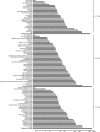Transcriptome sequencing and differential gene expression analysis of the schistosome-transmitting snail Oncomelania hupensis inhabiting hilly and marshland regions
- PMID: 29150650
- PMCID: PMC5693929
- DOI: 10.1038/s41598-017-16084-z
Transcriptome sequencing and differential gene expression analysis of the schistosome-transmitting snail Oncomelania hupensis inhabiting hilly and marshland regions
Abstract
The freshwater snail Oncomelania hupensis is the unique intermediate host of the blood fluke Schistosoma japonicum, which is the major cause of schistosomiasis. The snail inhabits two contrasting environments: the hilly and marshland regions. The hilly snails are smaller in size and have the typical smooth shell, whereas the marshland snails are larger and possess the ribbed shell. To reveal the differences in gene expression between the hilly and marshland snails, a total of six snails, three per environment, were individually examined by RNA sequencing technology. All paired-end reads were assembled into contigs from which 34,760 unigenes were predicted. Based on single nucleotide polymorphisms, principal component analysis and neighbor-joining clustering revealed two distinct clusters of hilly and marshland snails. Analysis of expression changes between environments showed that upregulated genes relating to immunity and development were enriched in hilly snails, while those associated with reproduction were over-represented in marshland snails. Eight differentially expressed genes between the two types of snails were validated by qRT-PCR. Our study identified candidate genes that could be targets for future functional studies, and provided a link between expression profiling and ecological adaptation of the snail that may have implications for schistosomiasis control.
Conflict of interest statement
The authors declare that they have no competing interests.
Figures






Similar articles
-
Compatibility of Schistosoma japonicum from the hilly region and Oncomelania hupensis hupensis from the marshland region within Anhui, China.Parasitol Res. 2014 Dec;113(12):4477-84. doi: 10.1007/s00436-014-4133-0. Epub 2014 Sep 9. Parasitol Res. 2014. PMID: 25199558
-
De Novo transcriptome analysis of Oncomelania hupensis after molluscicide treatment by next-generation sequencing: implications for biology and future snail interventions.PLoS One. 2015 Mar 16;10(3):e0118673. doi: 10.1371/journal.pone.0118673. eCollection 2015. PLoS One. 2015. PMID: 25775015 Free PMC article.
-
[Investigation of Oncomelania hupensis snails in Anhui Province in 2016].Zhongguo Xue Xi Chong Bing Fang Zhi Za Zhi. 2018 May 30;30(5):493-499. doi: 10.16250/j.32.1374.2017224. Zhongguo Xue Xi Chong Bing Fang Zhi Za Zhi. 2018. PMID: 30567017 Chinese.
-
Biology and Control of Snail Intermediate Host of Schistosoma japonicum in The People's Republic of China.Adv Parasitol. 2016;92:197-236. doi: 10.1016/bs.apar.2016.02.003. Epub 2016 Apr 7. Adv Parasitol. 2016. PMID: 27137448 Review.
-
Oncomelania hupensis quadrasi: Snail intermediate host of Schistosoma japonicum in the Philippines.Acta Trop. 2020 Oct;210:105547. doi: 10.1016/j.actatropica.2020.105547. Epub 2020 May 29. Acta Trop. 2020. PMID: 32479837 Review.
Cited by
-
Temporal transcriptome change of Oncomelania hupensis revealed by Schistosoma japonicum invasion.Cell Biosci. 2020 Apr 17;10:58. doi: 10.1186/s13578-020-00420-4. eCollection 2020. Cell Biosci. 2020. PMID: 32328235 Free PMC article.
-
Treading the Path towards Genetic Control of Snail Resistance to Schistosome Infection.Trop Med Infect Dis. 2018 Aug 15;3(3):86. doi: 10.3390/tropicalmed3030086. Trop Med Infect Dis. 2018. PMID: 30274482 Free PMC article. Review.
-
Whole genome resequencing reveals signatures of rapid selection in a virus-affected commercial fishery.Mol Ecol. 2022 Jul;31(13):3658-3671. doi: 10.1111/mec.16499. Epub 2022 May 31. Mol Ecol. 2022. PMID: 35555938 Free PMC article.
-
Transcriptome analysis of air-breathing land slug, Incilaria fruhstorferi reveals functional insights into growth, immunity, and reproduction.BMC Genomics. 2019 Feb 26;20(1):154. doi: 10.1186/s12864-019-5526-3. BMC Genomics. 2019. PMID: 30808280 Free PMC article.
References
MeSH terms
LinkOut - more resources
Full Text Sources
Other Literature Sources
Research Materials

